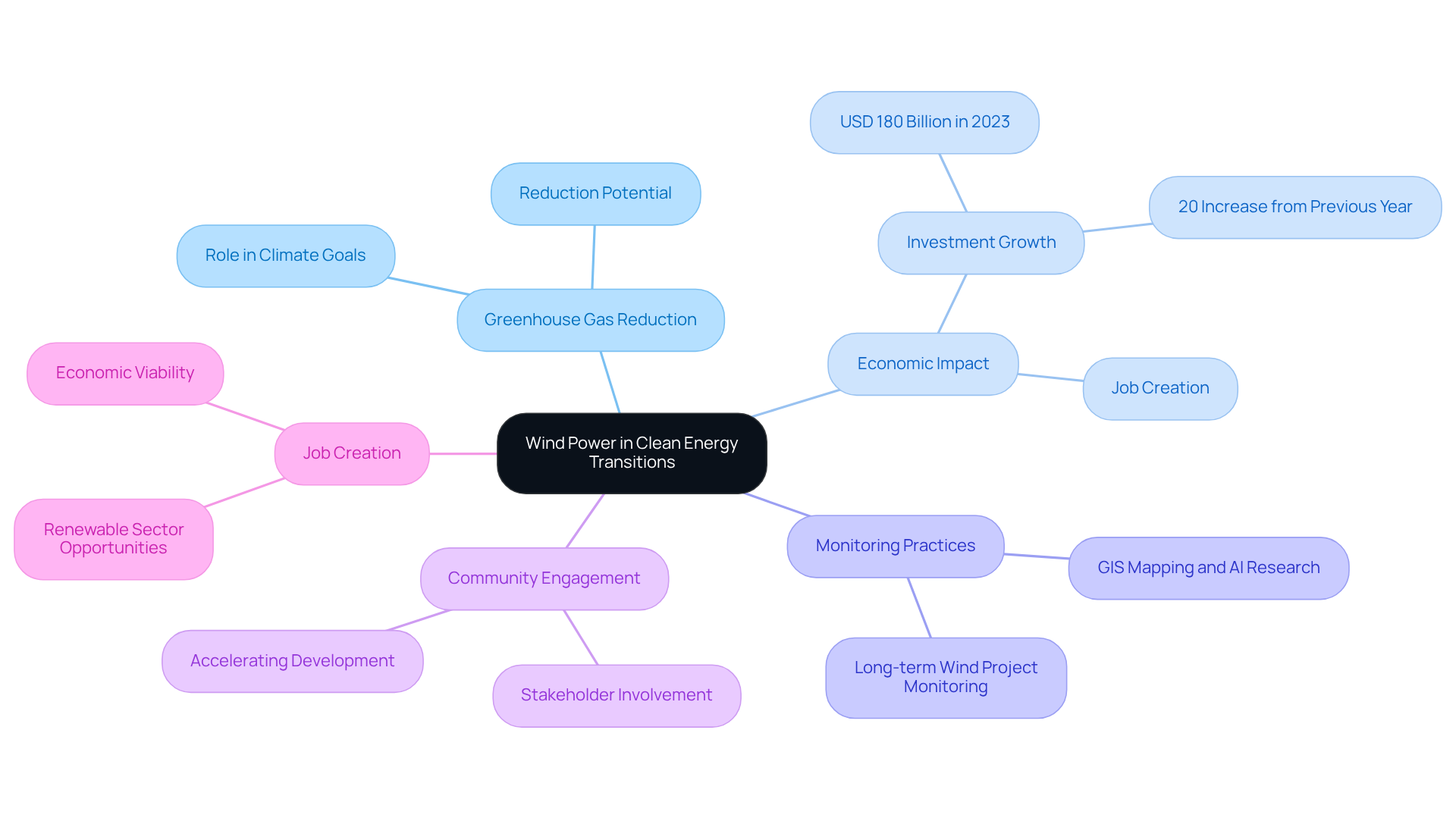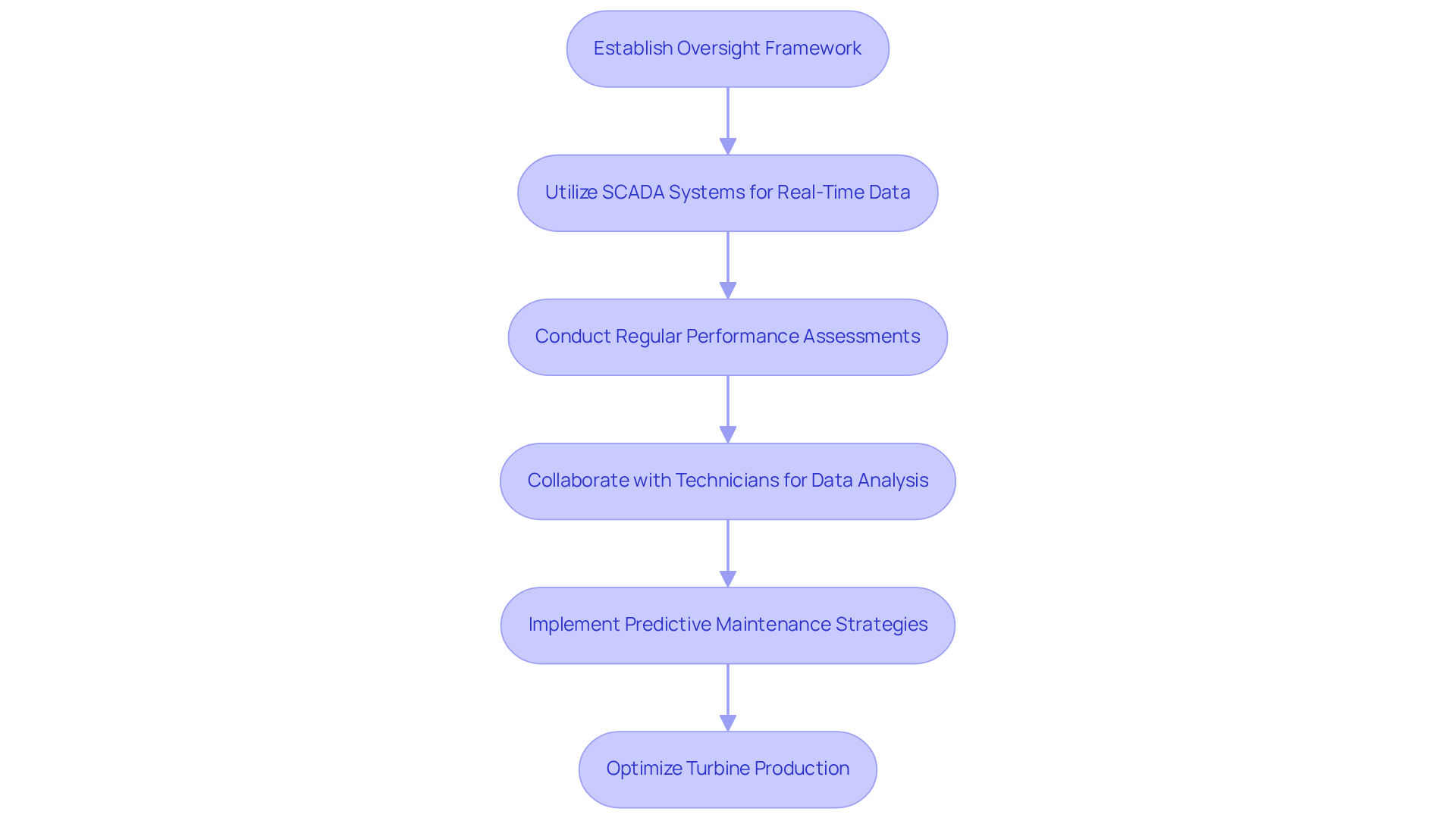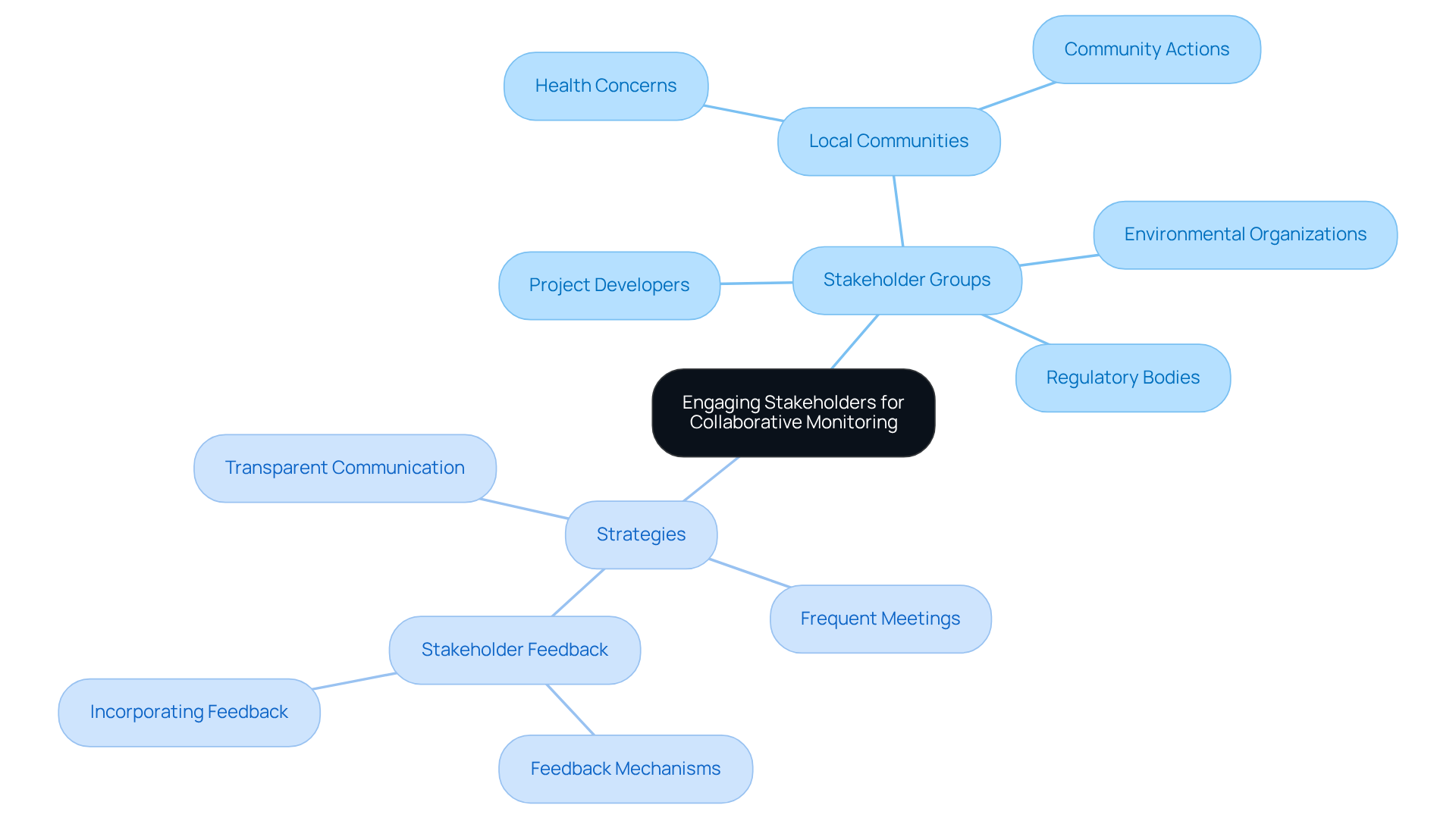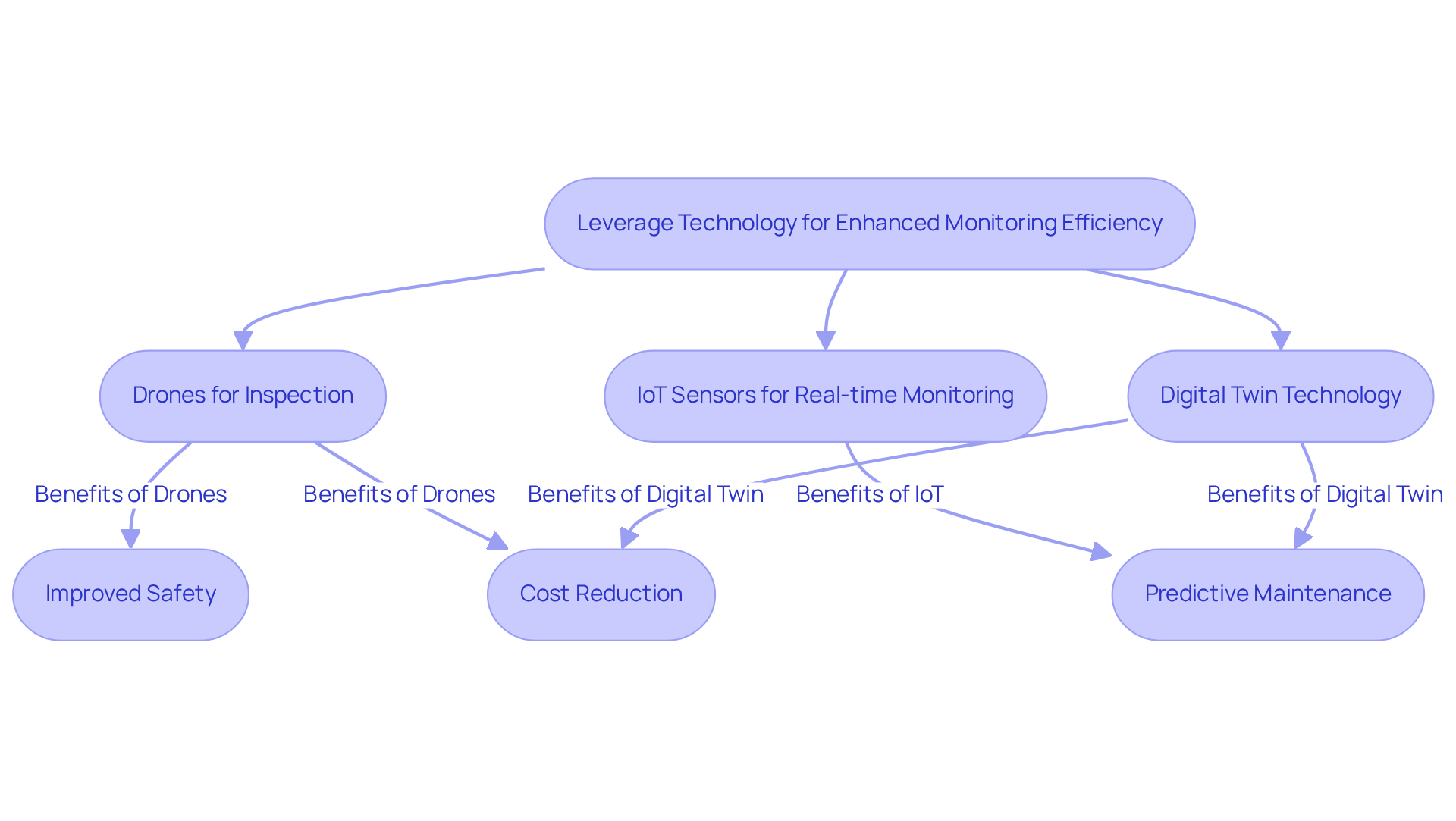Overview
The article presents four pivotal strategies for attaining long-term success in wind project monitoring, underscoring the necessity of integrating effective oversight practices, engaging stakeholders, and leveraging advanced technologies. These strategies are bolstered by discussions that highlight the critical role of real-time data collection and community involvement. Moreover, technological innovations such as drones and IoT sensors are examined, as they collectively enhance the efficiency and sustainability of wind energy initiatives.
Introduction
As the world pivots towards cleaner energy solutions, wind power emerges as a cornerstone of this transformative journey. Projections indicate that it could generate 20% of global electricity by 2040. However, the success of wind projects is contingent not only upon their implementation but also on the effectiveness of long-term monitoring strategies that ensure optimal performance and sustainability.
What challenges do stakeholders face in maintaining oversight?
How can innovative technologies and collaborative practices be harnessed to enhance monitoring efforts?
Understand the Role of Wind Power in Clean Energy Transitions
Wind power is essential to the global transition towards clean energy sources, playing a vital role in reducing greenhouse gas emissions. As nations strive to meet their climate goals, wind power emerges as one of the most economical and expandable renewable resources available. The International Energy Agency (IEA) forecasts that wind power could account for as much as 20% of global electricity production by 2040, underscoring its potential impact on the energy landscape. This transition not only aids in combating climate change but also enhances resource security and promotes job creation within the renewable sector.
For stakeholders involved in turbine initiatives, understanding this context is crucial. It emphasizes the importance of adopting effective monitoring practices, such as long-term wind project monitoring, to ensure the sustainability and efficiency of energy systems. Companies such as Harbinger Land provide extensive land services, including site and right-of-way acquisition, utilizing advanced GIS mapping and AI-driven title research to streamline lease acquisition and site selection for renewable energy projects.
Comprehending community engagement in site selection is essential. Harbinger Land employs specific strategies to involve local stakeholders, thereby accelerating development. This growing market confidence highlights the economic viability of renewable energy as a key component of the global energy transition.

Implement Effective Monitoring Practices for Wind Projects
To ensure the long-term success of renewable energy initiatives, long-term wind project monitoring and effective oversight practices are essential. A robust oversight framework utilizing advanced technologies, such as SCADA (Supervisory Control and Data Acquisition) systems, is essential for long-term wind project monitoring as it provides real-time data on turbine performance and environmental conditions. Regular performance assessments are crucial for long-term wind project monitoring, as they help identify deviations from expected outputs and enable timely interventions. As highlighted by SBL Solutions, "Collaborating with proficient technicians who can analyze the data and identify issues that require resolution is equally crucial as assessing turbine performance."
Moreover, long-term wind project monitoring through predictive maintenance strategies allows for the anticipation of potential failures before they occur, thereby minimizing downtime and reducing maintenance costs. Techniques such as vibration analysis and thermal imaging can detect early signs of wear and tear in turbine components, ensuring proactive maintenance rather than reactive responses.
A properly located 6 kW turbine can generate up to 9,000 kWh of power annually, underscoring the significance of efficient oversight methods in optimizing production. While concerns regarding wildlife impacts exist, the overall benefits of renewable energy, particularly from turbines, significantly outweigh these issues, contributing to a sustainable future.
In conclusion, the integration of effective oversight practices is not just beneficial but necessary for the success of long-term wind project monitoring. By embracing advanced technologies and proactive maintenance approaches, stakeholders can ensure that these initiatives thrive, paving the way for a greener tomorrow.

Engage Stakeholders for Collaborative Monitoring Success
Effective oversight of wind projects necessitates robust engagement with all stakeholders, including project developers, local communities, regulatory bodies, and environmental organizations. Establishing transparent communication channels is critical for fostering trust and collaboration. Frequent stakeholder meetings facilitate discussions about evaluation results, address concerns, and collaboratively develop solutions to emerging issues. Actively integrating stakeholder feedback not only enhances oversight practices but also ensures alignment with the diverse needs of all parties involved. Notably, 70 municipalities have expressed reluctance to accommodate renewable initiatives, underscoring the urgent need for effective communication strategies. By cultivating a cooperative atmosphere, project leaders can significantly enhance the efficiency of oversight efforts, ultimately contributing to the sustained success of renewable energy projects. As Angela Rodgers aptly stated, "Tapping into stakeholder perspectives can shape your decision-making, mitigate risk, avoid costly problems, build trust, and drive more sustainable outcomes.

Leverage Technology for Enhanced Monitoring Efficiency
Incorporating advanced technologies into turbine oversight practices significantly enhances both efficiency and precision. Drones, such as the DJI Matrice 300 RTK and DJI Mavic 3 Enterprise Advanced, equipped with thermal imaging cameras, enable detailed inspections of turbine blades and components. These inspections reveal potential issues that may remain hidden from ground-level assessments. For instance, thermal drones can detect hidden defects such as blade delamination and electrical problems by measuring surface temperature variations.
Furthermore, the deployment of IoT (Internet of Things) sensors facilitates ongoing observation of turbine performance, enabling real-time data collection and analysis. This data can be harnessed through machine learning algorithms to predict maintenance needs and optimize operational strategies. Ultimately, this reduces downtime and repair costs, which can reach up to $30,000 annually per turbine without preventative maintenance.
Moreover, the application of digital twin technology generates virtual models of energy farms, allowing operators to simulate various scenarios and assess the effects of different operational strategies. A case study on the challenges faced in traditional inspection methods highlights how drones have transformed the process. They provide close-up HD images and thermal data from all angles, significantly improving safety and reducing labor costs.
By leveraging these innovative technologies, wind project managers can enhance long-term wind project monitoring efficiency, lower costs, and improve overall project performance. Are you ready to embrace these advancements and transform your turbine oversight practices?

Conclusion
The path to a sustainable energy future is fundamentally dependent on the effective monitoring of wind projects, which play a crucial role in the global transition to clean energy. By adopting robust oversight practices and leveraging advanced technologies, stakeholders can ensure these projects not only meet performance expectations but also make significant contributions to reducing greenhouse gas emissions and enhancing resource security.
Key strategies for successful long-term wind project monitoring encompass:
- Implementation of effective practices
- Stakeholder engagement
- Embrace of innovative technologies
These strategies facilitate real-time assessments of turbine performance and foster collaboration among project developers, local communities, and regulatory bodies. By prioritizing transparent communication and actively seeking stakeholder feedback, projects can cultivate enhanced trust and cooperation—essential elements for addressing challenges and optimizing outcomes.
Ultimately, a commitment to long-term wind project monitoring transcends mere operational efficiency; it represents a vital step toward achieving broader renewable energy objectives. As the world grapples with the urgent challenges posed by climate change, the integration of technology and stakeholder engagement in wind energy initiatives will be instrumental in shaping a cleaner, more sustainable future. Embracing these strategies is imperative for all participants in the renewable sector, ensuring that wind power fulfills its promise as a cornerstone of the global energy transition.
Frequently Asked Questions
What is the role of wind power in clean energy transitions?
Wind power is essential for the global transition to clean energy, significantly reducing greenhouse gas emissions and supporting climate goals.
How much of global electricity production could wind power account for by 2040?
The International Energy Agency (IEA) forecasts that wind power could account for as much as 20% of global electricity production by 2040.
What are the benefits of transitioning to wind power?
Transitioning to wind power helps combat climate change, enhances resource security, and promotes job creation within the renewable energy sector.
Why is monitoring practices important for wind power projects?
Effective monitoring practices, such as long-term wind project monitoring, are crucial to ensure the sustainability and efficiency of energy systems.
What services does Harbinger Land provide for renewable energy projects?
Harbinger Land offers extensive land services, including site and right-of-way acquisition, utilizing advanced GIS mapping and AI-driven title research to streamline lease acquisition and site selection.
How does community engagement play a role in site selection for wind power projects?
Harbinger Land employs specific strategies to involve local stakeholders in the site selection process, which helps accelerate development and builds market confidence in renewable energy's economic viability.
List of Sources
- Understand the Role of Wind Power in Clean Energy Transitions
- Global overview – Renewables 2024 – Analysis - IEA (https://iea.org/reports/renewables-2024/global-overview)
- 20 Quotes To Get You Inspired For a Renewable Future - Solstice (https://solstice.us/solstice-blog/20-quotes-for-a-renewable-future)
- Wind - IEA (https://iea.org/energy-system/renewables/wind)
- Market and Industry Trends | Wind Power (https://ren21.net/gsr-2024/modules/energy_supply/02_market_and_industry_trends/09_windpower)
- WWEA Annual Report 2023: Record Year for Windpower (https://wwindea.org/AnnualReport2023)
- Implement Effective Monitoring Practices for Wind Projects
- Wind Power Quotes: 16 Inspiring Picks (2025) (https://lumifyenergy.com/blog/wind-power-quotes)
- 'I know windmills very much': Trump's top 10 wind power quotes (https://rechargenews.com/wind/i-know-windmills-very-much-trumps-top-10-wind-power-quotes/2-1-729724)
- How to Monitor Wind Turbine Performance - SBL Solutions (https://sblsolutions.com.au/news/how-to-monitor-wind-turbine-performance)
- A review of SCADA-based condition monitoring for wind turbines via artificial neural networks (https://sciencedirect.com/science/article/abs/pii/S0925231225005028)
- Top Ten Quotes about Wind Energy and Windmills (https://solar-us-shop.com/blogs/solar-blog/top-ten-quotes-about-wind-energy-and-windmills?srsltid=AfmBOoocrVC1Vp3onCPelCF4y2cDVJR99ll7InayudJdhpezsYCc4n8J)
- Engage Stakeholders for Collaborative Monitoring Success
- Stakeholder Feedback: Methods & Best Practices (https://simplystakeholders.com/stakeholder-feedback)
- Ontario’s Experience of Wind Energy Development as Seen through the Lens of Human Health and Environmental Justice - PMC (https://pmc.ncbi.nlm.nih.gov/articles/PMC4962225)
- Immediate actions for the European wind power industry (https://ec.europa.eu/commission/presscorner/detail/en/ip_23_5185)
- A stakeholder analysis of investments in wind power electricity generation in Ontario (https://sciencedirect.com/science/article/abs/pii/S0140988321004412)
- WWEA Annual Report 2023: Record Year for Windpower (https://wwindea.org/AnnualReport2023)
- Leverage Technology for Enhanced Monitoring Efficiency
- Wind Turbine Inspection using Drones (https://dronenodes.com/wind-turbine-drone-inspection)
- 'I know windmills very much': Trump's top 10 wind power quotes (https://rechargenews.com/wind/i-know-windmills-very-much-trumps-top-10-wind-power-quotes/2-1-729724)
- Wind Power Quotes: 16 Inspiring Picks (2025) (https://lumifyenergy.com/blog/wind-power-quotes)
- Drone Innovation empowers Wind Energy: Efficient Monitoring and optimization of Wind Farm management (https://investindk.com/insights/drone-innovation-empowers-wind-energy)
- The Benefits of Using Drones for Inspecting Wind Turbines (https://hammermissions.com/post/the-benefits-of-using-drones-for-inspecting-wind-turbines)




